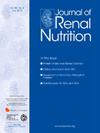饥荒对中国大饥荒幸存者晚年eGFR下降的影响:一项回顾性研究。
IF 3.2
3区 医学
Q2 NUTRITION & DIETETICS
引用次数: 0
摘要
背景和目的:慢性肾脏病(CKD)严重加重了中国乃至全球的社会经济负担。先前的研究表明,经历童年饥荒与糖尿病、高血压和蛋白尿等多种慢性疾病有关。然而,早期饥荒对成年肾功能的长期影响仍不清楚。本研究调查了遭受中国大饥荒(1959-1962 年)是否与日后肾小球滤过率(GFR)的下降有关:CHARLS是一项基于人群的观察性研究。我们分析了 2011-2012 年基线调查(2014 年更新)中 8828 名参与者的数据。根据出生年份将参与者分为胎儿暴露组(1959-1962 年)、儿童暴露组(1949-1958 年)、青少年/成人暴露组(1912-1948 年)和非暴露组(1963-1989 年)。采用 CKD-EPI-Cr-Cys 公式(2021 年)计算估计的 GFR(eGFR),eGFR 低于 60 mL/min/1.73 m2 即为 CKD:胎儿暴露组、儿童暴露组、青少年/成人暴露组和非暴露组的 eGFR 平均值分别为 103.0、96.8、91.2 和 76.3 mL/min/1.73 m2。与非暴露组相比,暴露组的 eGFR 明显较低。具体来说,暴露于饥荒与较低的肾小球滤过率相关(CE -9.14,95%CI -9.46,-8.82),青少年/成人暴露组的相关性最强(CE -26.74,95%CI -27.75,-25.74)。对人口统计学、体格检查和实验室检查、并发症以及吸烟和饮酒等个人习惯等变量进行调整后,这一关联并没有发生质的改变(CE -1.38,95%CI -1.72,-1.04)。根据性别、体重指数(BMI)、饮酒史、高血压、糖尿病、CESD评分和教育水平进行的进一步分层显示,这种关联性保持一致:结论:在人的不同生命阶段遭受饥荒会对肾小球滤过率的下降产生持久的影响。本文章由计算机程序翻译,如有差异,请以英文原文为准。
Consequences of Exposure to Famine Exposure on the Later Life eGFR Decline Among Survivors of the Great Chinese Famine: A Retrospective Study
Objectives
Chronic kidney disease (CKD) significantly contributes to the socio-economic burden both in China and worldwide. Previous research has shown that experiencing childhood famine is linked to various chronic conditions like diabetes, hypertension, and proteinuria. However, the long-term effects of early-life famine exposure on adult kidney function remain unclear. This study investigates whether exposure to the Chinese Great Famine (1959-1962) is associated with a decline in glomerular filtration rate (GFR) later in life.
Design and Methods
China Health and Retirement Longitudinal Study is a population-based observational study. We analyzed data from 8,828 participants in the 2011-2012 baseline survey, updated in 2014. Participants were categorized based on their birth year into fetal-exposed (1959-1962), childhood-exposed (1949-1958), adolescence/adult-exposed (1912-1948), and nonexposed (1963-1989) groups. The estimated GFR (eGFR) was calculated using the CKD-EPI-Cr-Cys equation (2021), with CKD defined as an eGFR below 60 mL/min/1.73 m2.
Results
Average eGFR values were 103.0, 96.8, 91.2, and 76.3 mL/min/1.73 m2 for the fetal-exposed, childhood-exposed, adolescence/adult-exposed, and nonexposed groups, respectively. The eGFR in the exposed groups was significantly lower compared to the nonexposed group. Specifically, famine exposure correlated with a lower eGFR (coefficient estimates [CE] −9.14, 95% confidence interval [CI] −9.46, −8.82), with the strongest association observed in the adolescence/adult-exposed group (CE −26.74, 95% CI −27.75, −25.74). Adjusting for variables such as demographics, physical and laboratory tests, complications, and personal habits like smoking and drinking did not qualitatively alter this association (CE −1.38, 95% CI −1.72, −1.04). Further stratification by sex, body mass index, alcohol consumption history, hypertension, diabetes, Center for Epidemiologic Studies Depression score, and education level showed that the association remained consistent.
Conclusions
Exposure to famine during different life stages can have enduring effects on GFR decline in humans.
求助全文
通过发布文献求助,成功后即可免费获取论文全文。
去求助
来源期刊

Journal of Renal Nutrition
医学-泌尿学与肾脏学
CiteScore
5.70
自引率
12.50%
发文量
146
审稿时长
6.7 weeks
期刊介绍:
The Journal of Renal Nutrition is devoted exclusively to renal nutrition science and renal dietetics. Its content is appropriate for nutritionists, physicians and researchers working in nephrology. Each issue contains a state-of-the-art review, original research, articles on the clinical management and education of patients, a current literature review, and nutritional analysis of food products that have clinical relevance.
 求助内容:
求助内容: 应助结果提醒方式:
应助结果提醒方式:


